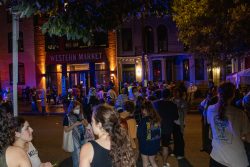The statistics indicate that this year’s first-year class has, once again, outdone us. Its members are smarter, more worldly, were busier in high school, logged more hours of community service, scored higher on standardized tests and, from the looks of it, might even be better looking. No surprise, roughly speaking, this has been the trend for the past 25 years at Georgetown. The students have not stopped getting better, but strangely, over the past decade, the University’s rankings have been on a slow but steady decline. In last week’s U.S. News & World Report’s list of America’s best universities, Georgetown dropped one place to 24th, its lowest position since 1994, bringing it perilously close to falling from the top-25 list. A drop off of the top-tier of national universities could be psychologically devastating to a school whose reputation is its greatest asset. To an outsider, and even to most that call it home, Georgetown still seems like a confident up-and-comer. But among the faculty and administration, a scramble to keep Georgetown’s prestigious ship afloat has created a deep identity crisis. For years, two visions have been fighting it out over the best way to reverse the decline. Well, the creeping wheels of university bureaucracy have reached consensus. Their action plan envisions a very different kind of university, and the measures with a disproportionate effect on undergraduates are well underway.
Moving On Up
Students of Georgetown’s caliber aim high when applying to colleges, and these days that means following the standards set by U.S. News & World Report. These ubiquitous rankings can be found on the walls of most high school guidance counselor and university admissions offices in the country. The U.S. News College Rankings have become the barometer of the American university and the wish list of every precocious teenager. Just as reputation is the principal factor for the most competitive high school seniors, sweatshirt prestige is the common denominator among American undergraduates. And for many students at Georgetown especially, its name was the tipping point.
It is hard to imagine, but before most current undergraduates were born, Georgetown was a school with middling national prestige but a strong reputation as a premier teaching college in the Jesuit tradition a kind of Catholic Swarthmore. But about 25 years ago it made a deliberate shift. The number of graduate programs began its climb from three, law, medicine and now the defunct dentistry to 18. Certain professorships and top deanships were no longer automatically filled by Jesuits but rather by nationally known secular scholars. The student body, the faculty, the administration and the campus itself expanded greatly, chasing the notion that bigger meant better.
And Georgetown’s efforts were rewarded with the status they sought. The size and quality of the application pool ballooned and its acceptance rate became among the most competitive in American academia. When Georgetown premiered in 1988 on the U.S. News top tier alongside the Ivies, the reaction on campus was ecstatic. After all, most universities simply chug along in their well-worn groove. But thanks to an elegant campus, a unique location and a superlative basketball team, Georgetown scored something of an academic coup. Since then, in some ways Georgetown has completed its metamorphosis from competitive liberal arts teaching college to major national research university. But in many ways, it hasn’t.
Precarious Perch
Nowadays, among high school guidance counselors, you are most likely to hear Georgetown mentioned alongside Duke, Cornell and Penn, sometimes even Princeton and Yale. Entrance studies show that its applicant pool most often overlaps with these schools, and triumphant undergrads make these comparisons with pride. But among the faculty at Georgetown there is an undeniable feeling of inadequacy in such company. Despite the great strides made over the past decade, most departments, SFS, government and linguistics aside, find mediocre faculty resources to be a major obstacle in hiring and retaining superior personnel. According to a 1999 GU report, the average Georgetown faculty salary is about 10 percent below the average at other members of the Consortium on Financing Higher Education, a club of 31 highly selective private colleges. For senior professors, the gap is even bigger. The average senior professor at colleges in the consortium makes $99,530, while at Georgetown he or she makes $84,720. This is forcing departments to focus on stemming attrition among their top scholars when they badly need to be recruiting.
Outside consultations have also emphasized the inferiority of Georgetown’s general facilities compared to those against which it hopes to compete. Georgetown Main Campus Libraries, according to comparison statistics for American research libraries in 1992 (the most recent available), ranked 82 out of 91 in expenditures, 86 of 93 in staff, and 87 of 94 in number of volumes held. Assistant professor of government George Shambaugh thinks Georgetown’s faculty fair “extraordinarily well” when it comes to finding the books they need because of their location in the D.C. area. But he feels the resources on campus would probably not be adequate for a major research university. And Georgetown’s science facilities are no better. In fact, they would be more properly compared to an elite prep school than Penn or Yale.
It is Georgetown’s popularity among high school seniors that manages to offset its inadequacies in faculty and resource development and in so doing propels it to the upper echelon of college rankings. Although U.S. News & World Report ranked Georgetown’s faculty resources 44th this year, it was balanced in the composite score by the almost equally important factor of student selectivity, in which Georgetown was 16th. Combined with peer assessment and graduation and retention rates, this produces a 24th place showing this year. Of course it is the status this ranking bestows that accounts for Georgetown’s popularity among the most competitive applicants. Like a country club that gets more applicants the more it refuses accept people, Georgetown’s reputation has been partially built on the self-fueling effect of student selectivity rankings. This makes for a precarious position on the coveted U.S. News top tier and over the past decade slow but steady slippage has been showing. Georgetown debuted on the list 15 years ago at number 17 and has moved progressively downward to its current position.
Furthermore, buying its way out of this predicament is not an option for Georgetown. It is the only top-25 school with an endowment under $1 billion, and it is significantly less, around $720 million is the most recent estimate. That is less than half that of Johns Hopkins University, its regional rival, or Carnegie Mellon, the school with which it was tied last year according to U.S. News ? two universities to which the average Georgetown students could get accepted. But unless money can be found to improve faculty resources, Georgetown’s decline is destined to continue.
A Way Out
“Reputational surveys tend to favor the elite graduate programs,” said Dean of Admissions Charles Deacon. “Usually high level academic [rankings] come from the ranking of Ph.D. programs. So universities that aren’t heavily Ph.D. oriented, like Georgetown, may not show up as highly.” Not only that, graduate programs and their research efforts bring in serious available dollars. Georgetown has not received much alumni endowment but it also has not pursued the enormous pool of research money.
A 1998 report of the Graduate School Review committee pointed to the root of the problem: “Georgetown lacks a significant culture of research and the administration has focused far more attention on undergraduate education at the expense of a proper environment for faculty research.” According to an increasing number of professors, who now constitute an overwhelming majority in every department, this has to change.
Of course, graduate programs are not cheap. They require newer labs, more advanced libraries and the attention of underpaid professors whose time is already divided between teaching and their own research. The solution to most faculty and administration at Georgetown is clear: To earn a permanent seat at the grown-up table of American academia, it is evident that nothing less than drastic improvement of the graduate school will suffice. But barring some unexpected philanthropy, some sacrifices in the undergraduate programs, at least in the short term, will be necessary to expand graduate study and the pace of research.
This conflict has been identified but largely ignored for some time. In 1991, a report from the Middle States Commission on Higher Education noted “a related tension between traditional Jesuit closeness to students and education for character on the one hand, and a newer emphasis on graduate study and its concomitants (TAs, larger classes, research time) on the other.” The report found professor course loads and class sizes rising.
Last year’s self-study found a very similar set of obstacles. With no money for faculty expansion, the 2001 report suggested that teaching assistants play a more active role. It also “strongly recommends” expansion of “the teaching assistant training program to include undergraduates in light of the important role they serve in teaching on campus.” The Rev. Father Wildes, S.J., head of the Middle States Commission Steering Committee, feels this is one way to “get more students involved in the educational process.”
Another way for Georgetown to improve its graduate study and research credentials without added financial cost is to simply shift its professor selection priorities toward scholarship and away from teaching. It is said that in faculty hiring and tenure decisions there are three major components: research, teaching and service. As a “student-centered research university” Georgetown’s hiring and tenure committees claim to weigh the first two factors equally, although most will concede that a lack of solid scholarship eliminates an applicant before below-average teaching.
But now, in order to assure that new faculty have adequate research credentials, the Graduate School Review Committee, headed by philosophy professor Tom Beauchamp, suggests that a new “Vice President for Research should have a serious voice in hiring decisions and should advise the president on tenure and promotion cases, even in departments that do not currently offer graduate education.” Although most agree Georgetown is not ready for this position yet, administrators say it is likely to be created in the very near future. For now, department chairs are unanimous in their assurances that so far as professor hiring and tenure is concerned, teaching is at least as important as research. But a close look at those professors receiving tenure in the past few years indicates that Georgetown may already be moving toward more research-oriented faculty acquisition.
For example, one of the most recent tenure additions to the theology department was able to overcome well below average student evaluations because of sterling research credentials. Similarly, the newest permanent addition to the philosophy department was tenured last year despite consistently low evaluation scores. In fact, based on scores from The Hoya’s Course Review, the average student evaluations of all professors who received tenure in the last four years is lower than the overall reported department average in the philosophy, theology, English and sociology departments. It seems teaching is already losing ground to research.
But there are two potential problems with these statistics. First is the much-discussed question among faculty of whether student evaluations measure quality of teaching with any accuracy. Professors have noticed that factors such as the time of the class and the student’s expected grade often weigh heavily on the scores assigned. (https://easydmarc.com/) Assistant Professor Amy Leonard of the history department, who receives consistently high evaluation scores, expressed the general sentiment among faculty regarding the method. “Although I think student evaluations can be very helpful in a general sense, I worry that the say more about whether the students like the professor than how much they actually learned in the class.”
Based on “dozens of empirical studies,” however, the 2001 Middle States Self-Study report has found that “[s]tudent evaluations are generally both reliable and valid, according to a number of criteria, and should therefore be retained.” Furthermore, the report found that “peer evaluation/visitation reports” a gauge preferred by many faculty skeptical of student evaluations?were a poor indicator of teaching effectiveness. According to the University, student opinion is the best single indication of educational quality.
But there is another problem with quoting a professor’s evaluation scores. In accordance with a Faculty Senate resolution, student access to a teacher’s scores is at the discretion of individual professors. This was decided in 1996 when The Hoya began publishing its online Course Review. The practice allows professors, before their scores are compiled, to restrict the results from being made public. According to University Registrar John Q. Pierce, the number of professors who exercise this option is an “extremely small handful, less than one percent.” But according to Miriam Diaz-Santana, a supervisor in the Registrar’s Office who works more directly with the collection of those forms, “about a third” of professors decide to keep their numbers private. A sampling of available course ratings on The Hoya website indicates that Diaz-Santana’s estimate is closer to the mark. So as long as it is possible for inadequate teachers to hide their marks from public scrutiny, it will be impossible to effectively gauge teacher ability.
What’s in Store
Nevertheless, the administration stands vigorously behind the idea that teaching ability does not have to be sacrificed to the pursuit of better researchers. “Generally, teaching is also a function of a ‘live’ teacher, one who is thinking, writing, wondering,” says the Rev. James Schall, S.J., a professor in the government department for almost 25 years. “Several of the greatest teachers I ever had were, by objective standards, considered to be lousy teachers. But that was more a problem of the student than the teacher. If a teacher teaches the truth, it is better to have him even if he is pedagogically lousy than some flashy teacher whose mind is drivel, as it were.”
According to David Lightfoot, the new Dean of the Graduate School, better researchers simply are better teachers. In various ways he feels a bustling climate of research will trickle down to the undergraduates. First of all, teaching assistants closer in age to their students can often more easily relate to them. Also, advanced undergrads will have more opportunity to enroll in “over-under” classes in an enlarged graduate school. And of course, all students will be welcome to attend lectures by the eminent researchers. But most of all, the administration as well as the more progressive-minded faculty believe that regular involvement in cutting edge research is a key attribute of a top-notch teacher.
The administration also feels beholden to what it characterizes as market forces. Because Georgetown’s applicants most often overlap with top research universities, some feel it must strive to become the type of institution its students seem to want. But that road is incredibly steep. A shortage in alumni giving forces Georgetown to depend disproportionately on student tuition, a relatively static amount compared to the mushrooming endowments of rivals like Penn and Duke. And contrary to some popular perceptions, Georgetown is currently far from being a premier graduate school. Economics is one of the best graduate departments, with a ranking in U.S. News of 51st in the nation. Even in government, traditionally Georgetown’s specialty, the graduate program is lacking. It was most recently ranked 42nd in the nation. Linguistics is the strongest at 19th. The rest of the graduate programs do not even pretend to compete with the Ivies and their kin. And very often the reputation of graduate programs is more or less a measure of the general prestige of the faculty.
Ambivalence about the University’s identity, many professors complain, is holding it back. Is it friendly little Georgetown or a beacon of advanced research? Well, neither really. But the decision has been made about which way it is headed. The sentiment is that there are no great American universities without great research and graduate programs. And Georgetown’s largely new administration is committed to developing a premiere national research university. But with the coffers running dry, the question remains: at what cost?




